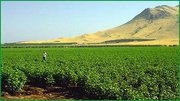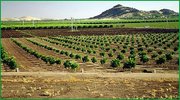Hardpan Terraces
Contents
Lithology and Stratigraphy
This subsection contains mostly Pleistocene alluvium, but some is older. In the northern part of the subsection, the alluvium is from volcanic, granitic, sedimentary, and metamorphic rock sources. The proportion of alluvium from granitic rock sources increases southward.
Geomorphology
This subsection consists of very gently to gently sloping terraces and small areas of floodplain and alluvial fans along streams that cross from mountains to reach the Sacramento and San Joaquin Rivers. The subsection elevation range is from 100 to about 400 feet. Fluvial erosion is the main geomorphic processes.
Soils
The soils are mostly Typic and Abruptic Durixeralfs and Typic, Mollic, and Ultic Palexeralfs. In relatively dry areas near the southern end of the San Joaquin Valley there are Xeric Torriorthents, Calcixerollic Xerochrepts, and Xeralfic Haplargids. The soils are well drained. Bicarbonate weathering and leaching and accumulation of clay and silica in subsoils are the main pedogenic processes in the terrace soils. Calcium carbonates accumulate in some of the drier soils. The soil temperature regimes are thermic. Soil moisture regimes are mostly xeric, but aridic at the southern end of the subsection.
Vegetation
The predominant natural plant communities are Needlegrass grasslands, and Northern hardpan vernal pools are common.
Characteristic series by lifeform include:
Climate
The mean annual precipitation is about 10 to 25 inches. It is practically all rain. Precipitation increases both toward the Sierra Nevada and toward the northern end of the Great Valley. Mean annual temperature is about 58° to 62° F. The mean freeze-free period is about 250 to 300 days.
Surface Water
Streams in this subsection drain to the Sacramento or San Joaquin Rivers or to closed basins in the San Joaquin Valley. All but the larger streams are generally dry during the summer. There are no lakes, but there is temporary ponding in vernal pools on Pleistocene terraces.



